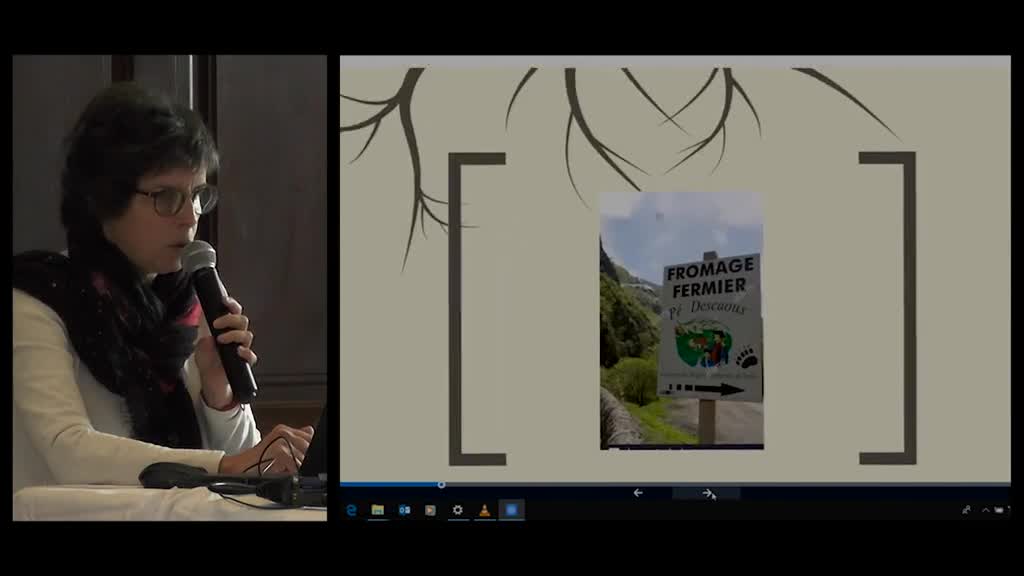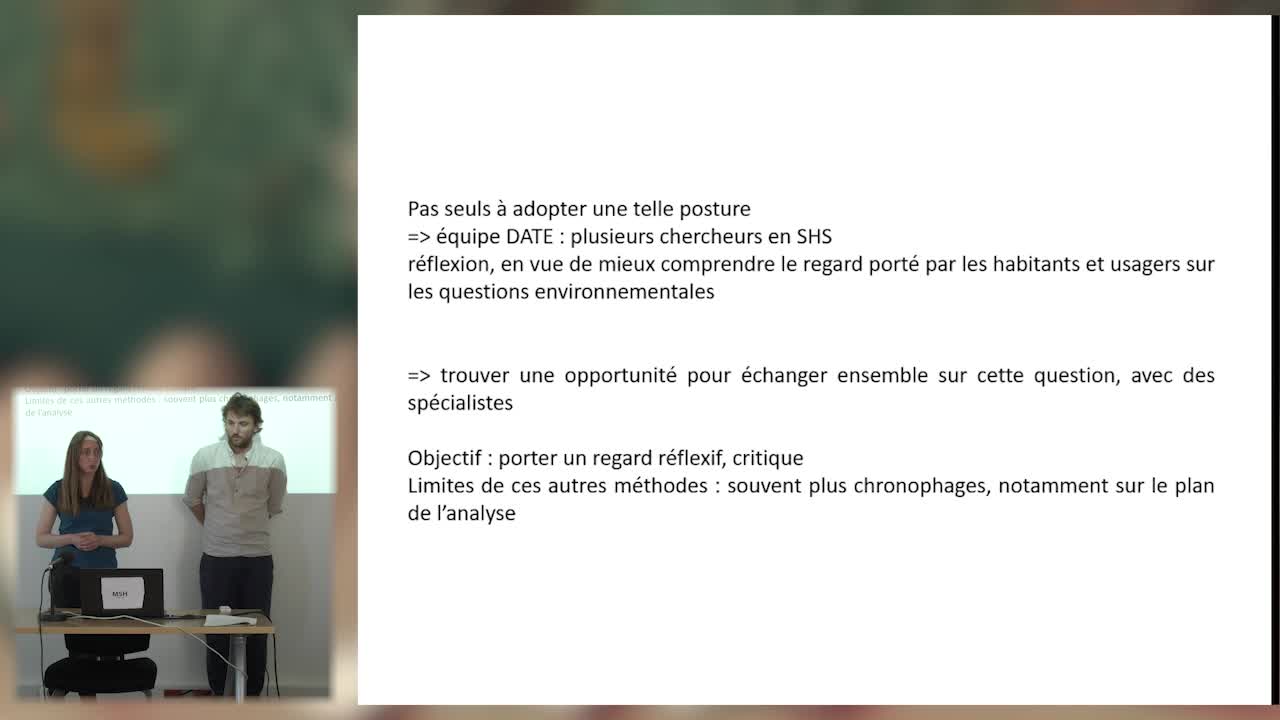Notice
24 - "Dynamique du paysage dans un domaine de chasse : la faune est-elle incompatible avec la forêt ? Exemple dans le Domaine national de Chambord (France) : Amélie Robert (UMR CITERES), Sylvie Servain (INSA Centre-Val de Loire)
- document 1 document 2 document 3
- niveau 1 niveau 2 niveau 3
Descriptif
COLLOQUE « HABITATS FORESTIERS ET FORÊTS HABITÉES » COMMENT USAGES, GESTIONS ET PRATIQUES SOCIALES INTERAGISSENT AVEC LA FAUNE SAUVAGE EN FORÊT ?"
Ce colloque international, qui s'est tenu au sein du Domaine national de Chambord (26 et 27 mars 2019), s'inscrit dans le cadre du projet de recherche COSTAUD (Contribution des OnguléS au foncTionnement de l’écosystème et AUx services rendus à ChamborD, financé par la Région Centre-Val de Loire et porté par l'Irstea, 2016-2019).
Toutes les informations sur le colloque : https://living-forests.sciencesconf.org/
Le colloque "Habitats forestiers et forêts habitées" a abordé la forêt, part de l'imaginaire et des paysages, comme lieu d’interactions entre l’homme et la faune sauvage.
Il a été l'occasion de réfléchir à l’empreinte passée de nos activités, aux déterminants actuels et leurs enjeux, ainsi qu’aux perspectives d’évolution des forêts et des habitats qui les composent.
Pour y parvenir ont été privilégiées les approches pluridisciplinaires tenant compte de l’écologie de la faune sauvage et des forêts, de leurs représentations sociales et de la fréquentation touristique associée à ces patrimoines naturel et culturel.
Session "Forêt et faune sauvage au sein du Domaine national de Chambord"
"Dynamique du paysage dans un domaine de chasse : la faune est-elle incompatible avec la forêt ? Exemple dans le Domaine national de Chambord (France) : Amélie Robert (UMR CITERES), Sylvie Servain (INSA Centre-Val de Loire)
Résumé de l'intervention :
<div>
The national estate of Chambord is the largest walled-enclosed park in Europe. Nowadays, it mainly includes a forest, extending over more than 5.000 ha. It is dedicated to biodiversity conservation, nature tourism but also hunting. In fact, the estate is populated by an important wildlife, especially ungulates. In this paper, we would like to question the link between wildlife and forest, from a geohistoric viewpoint, basing on this case study. Our comments are results of a research we conducted in the framework of a project funded by the French Region Centre-Val de Loire. We compared old maps, aerial photographs and vectorial data in a GIS to identify the land use dynamics. To discuss the changes, we consulted archives and literature. Here, we will almost referred to the account of a forest ranger of Chambord.
When the Chambord park began to be walled in 1524, the purpose was already to create a hunting estate. But forest was not so important than nowadays. The change occurred later, especially during the 19th century: like in the surrounding area, plantations programs increase the forest area inside walls. In the same time, agriculture declined. Since 1950's, the forest area remained stable, thus high. Consequently, analyzing the landscape dynamics, we could conclude that the willingness to favor hunting and, through this one, wildlife conducted to favor forest. But this idea is counterbalanced by the account of the first forest ranger, J. Thoreau, which was in charge of the management of the Chambord forest from 1947. His account is, in a way, representative of the point of view of the forest managers: hunting management is incompatible with forest management, because it implies high densities of game. Indeed, browsing by wildlife can compromise forest regeneration. J. Thoreau thus emphasizes the defense of « forest against game » and deplores the high populations, the priority given to game at the expense of forest, what is particularly problematic in an enclosed park. Nowadays, even if the forest is still not a production forest, the estate tries to find a balance, being more oriented towards biodiversity conservation and nature tourism.
Intervention / Responsable scientifique
Dans la même collection
-
22 - "L'ours brun, bouc émissaire des usagers de la montagne" : Françoise Saliou (Chercheuse indépe…
SaliouFrançoiseCOLLOQUE « HABITATS FORESTIERS ET FORÊTS HABITÉES » COMMENT USAGES, GESTIONS ET PRATIQUES SOCIALES INTERAGISSENT AVEC LA FAUNE SAUVAGE EN FORÊT ?" Ce colloque international, qui s'est tenu
-
14 - "L'animal, facteur de paysage : agro-sylvo-pastoralisme dans le Morvan et à Sumatra" : Jean-Ba…
Ce colloque international, qui s'est tenu au sein du Domaine national de Chambord (26 et 27 mars 2019), s'inscrit dans le cadre du projet de recherche COSTAUD (Contribution des OnguléS au
-
06 - "La pression de l'étalement urbain sur la faune et la flore de la région du Grand Beyrouth (Li…
Ce colloque international, qui s'est tenu au sein du Domaine national de Chambord (26 et 27 mars 2019), s'inscrit dans le cadre du projet de recherche COSTAUD (Contribution des OnguléS au
-
28 - "Effets directs et indirects des ongulés sur l'échec de la nidification des oiseaux forestiers…
Ce colloque international, qui s'est tenu au sein du Domaine national de Chambord (26 et 27 mars 2019), s'inscrit dans le cadre du projet de recherche COSTAUD (Contribution des OnguléS au
-
19 - "Les relations entre les chauves-souris insectivores (Chiroptera) et les peuplements forestier…
Ce colloque international, qui s'est tenu au sein du Domaine national de Chambord (26 et 27 mars 2019), s'inscrit dans le cadre du projet de recherche COSTAUD (Contribution des OnguléS au
-
11- Exploitation des ressources naturelles de la réserve de faune de Lomako-Yokokala, province de l…
Ce colloque international, qui s'est tenu au sein du Domaine national de Chambord (26 et 27 mars 2019), s'inscrit dans le cadre du projet de recherche COSTAUD (Contribution des OnguléS au
-
03 - "La chasse en Wallonie : Poison ou remède ?" : Alix Hubert (Université de Liège)
Ce colloque international, qui s'est tenu au sein du Domaine national de Chambord (26 et 27 mars 2019), s'inscrit dans le cadre du projet de recherche COSTAUD (Contribution des OnguléS au
-
25- "Les animaux du château. Le tourisme de nature à Chambord" : Jean-Louis Yengué (Université de P…
Ce colloque international, qui s'est tenu au sein du Domaine national de Chambord (26 et 27 mars 2019), s'inscrit dans le cadre du projet de recherche COSTAUD (Contribution des OnguléS au
-
16 - "Gestion du risque par les ongulés sauvages face à différents prédateurs" : Nadège Bonnot (IRS…
Ce colloque international, qui s'est tenu au sein du Domaine national de Chambord (26 et 27 mars 2019), s'inscrit dans le cadre du projet de recherche COSTAUD (Contribution des OnguléS au
-
08 - "Le statut des parcs animaliers de la Pendjari et du W au regard de leur protection pénale" : …
Ce colloque international, qui s'est tenu au sein du Domaine national de Chambord (26 et 27 mars 2019), s'inscrit dans le cadre du projet de recherche COSTAUD (Contribution des OnguléS au
-
21 - "Réflexions d'une paysagiste sur la progression des boisements spontanés dans les Alpes et les…
COLLOQUE « HABITATS FORESTIERS ET FORÊTS HABITÉES » COMMENT USAGES, GESTIONS ET PRATIQUES SOCIALES INTERAGISSENT AVEC LA FAUNE SAUVAGE EN FORÊT ?" Ce colloque international, qui s'est tenu
Avec les mêmes intervenants et intervenantes
-
Anticiper la transition ? Gestionnaires et transformateurs face aux changements climatiques en forê…
ServainSylvieGinterZoéSession 3a : Questionner les adaptations de la filière/Questionning adaptations of the forestry sector and alternatives
-
What do residents and users think about forests in transitions? Methods used in the Compiègne fores…
RobertAmélieSession 3b : Prendre en compte les regards de la société/Taking society’s viewpoints into inccount
-
Conclusion du colloque
RobertAmélieAmélie Robert, Ecologie et Dynamique des Systèmes Anthropisés/UMR CNRS 7058, Cités, Territoires, Environnement et Sociétés
-
Forest plantations: the views of local stakeholders, users and residents
RobertAmélieLefebvreFélixSession plénière 5 : Questionner la piste des plantations/Questioning the plantation solution (session Plantaclim)
-
Plantaclim, an interdisciplinary project to study the ecosystem services provided by forest plantat…
RobertAmélieSession plénière 5 : Questionner la piste des plantations/Questioning the plantation solution (session Plantaclim)
-
Introduction au colloque
RobertAmélieLe colloque traitera d'un sujet éminemment d'actualité : les forêts, ce dans toute leur diversité (plantées ou spontanées ; urbaines ou rurales ; tempérées, tropicales, boréales...). Elles
-
-
-
5 - "Les plantations forestières : une solution face aux changements globaux ?"
RobertAmélieLes plantations forestières sont aujourd’hui particulièrement encouragées, en tant que moyen d’atténuation du changement climatique, via la séquestration et le stockage du carbone qu’elles autorisen.
-
Séminaire « La filière forêt-bois face aux changements globaux : quelles adaptations ?» (introduct…
RobertAmélieLe séminaire est organisé par l’équipe du projet Plantaclim (financé par la région Centre-Val de Loire), avec le soutien de l’UMR CITERES, du réseau thématique de recherche Milieux et Diversité (MiDi)
-
Plantaclim project: reflections for the future of forest plantations in the French Region Centre-Va…
RobertAméliePrésentation d'Amélie Robert (UMR CITERES, Université de Tours)
-
09 - "Pratiques des populiculteurs, les conseils donnés par le CRPF" : Léa Boubet (CRPF IDF CVL). P…
RobertAmélieBoubetLéaSéminaire interdisciplinaire et international "Les plantations forestières : représentations et réalité" Séminaire organisé dans le cadre du projet « Reforesté » Reforesté (Représentations et
























